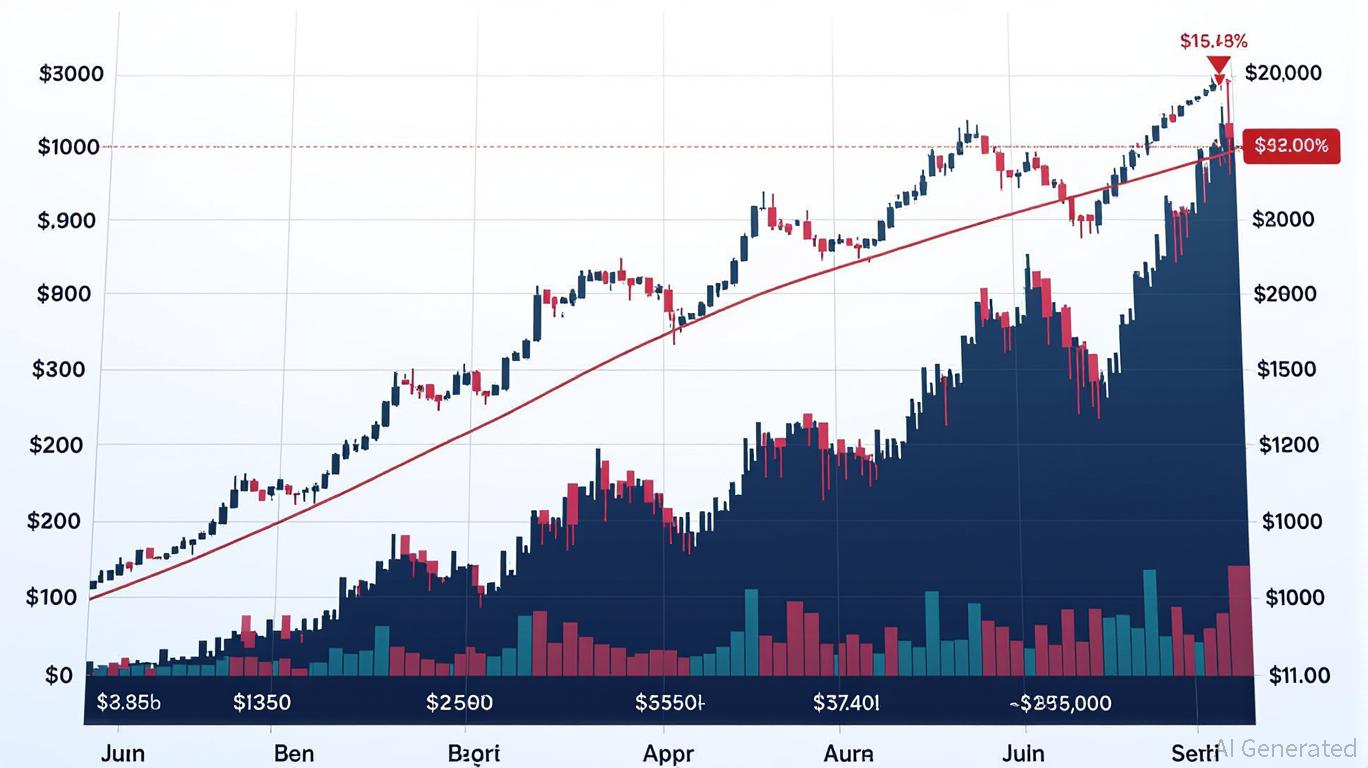Bitcoin Leverage Liquidation Patterns: Managing Risk Amidst Crypto Market Volatility
- 2025 crypto liquidation events exposed leverage risks, with $2B+ daily losses from Bitcoin’s volatility and thin liquidity. - Structural flaws like over-leveraged positions and inadequate buffers worsen cascading price declines during crashes. - Panic selling and herd behavior amplified losses, as seen in Ethereum and Solana’s $239M combined liquidations. - Experts urge diversified portfolios, automated tools, and liquidity-aware strategies to mitigate leverage-driven risks.
Crypto Market Turbulence in 2025: Lessons from Extreme Volatility
The year 2025 has exposed the inherent instability of leveraged trading in the cryptocurrency sector, as dramatic price fluctuations in Bitcoin have led to massive liquidation events. In one notable instance in November, Bitcoin’s value plunged below $81,000, resulting in nearly $2 billion in liquidations on Hyperliquid within a single day. Notably, over three-quarters of these losses came from long positions. This followed an even more severe crash in October, when $19 billion was wiped out in just 24 hours, intensifying concerns about the risks tied to leveraged trading. These incidents raise a pressing question: How can investors safeguard their assets in an environment where both market structure and trader behavior magnify volatility?
Structural Instability: The Role of Leverage and Liquidity
High leverage and limited liquidity have combined to create a feedback loop of instability in the crypto market. During the November downturn, open interest in Bitcoin dropped by $700 million in just two days, signaling a rapid retreat of leveraged capital. Experts point to deep-rooted issues such as excessive leverage and insufficient liquidity reserves, both of which intensify price swings. While the October crash was triggered by spot selling, November’s collapse was primarily driven by leverage, illustrating how different factors can set off chain reactions that destabilize the market.

Trading platforms like Hyperliquid have become focal points for systemic risk, as swift liquidations can spark downward spirals. According to Spectrum Search, market liquidity becomes extremely fragile during periods of stress, and forced selling by leveraged traders can accelerate declines. Broader economic factors—such as changes in Federal Reserve policy and regulatory actions in Asia—further undermine investor confidence and contribute to instability.
Behavioral Traps: Panic and Herd Reactions
In addition to structural weaknesses, the collective psychology of traders has worsened market crises. Panic selling and herd mentality—where investors rush to exit without a clear strategy—have amplified losses during sharp downturns. For example, the November liquidation wave saw Ethereum and Solana suffer losses of $183 million and $56 million, respectively, as fear spread across the crypto landscape.
Analysts note that psychological pressures often override rational judgment. As highlighted in a Forbes report, traders frequently misjudge their risk tolerance until forced to act by leverage, with emotional responses compounding the impact of volatile markets. This vulnerability is especially evident in leveraged trading, where margin calls and liquidations can trigger panic-driven decisions that worsen market instability.
Effective Risk Management: Practical Strategies for Investors
To navigate these risks, investors should embrace disciplined, evidence-based approaches. Consider the following strategies:
-
Diversification and Position Sizing
Spreading investments across large-cap assets (such as Bitcoin and Ethereum), mid-caps (like Polygon and Arbitrum), and smaller coins, while maintaining stablecoins as a safety net, helps reduce exposure to any single asset’s failure. It’s vital to only risk amounts one can afford to lose and to adjust allocations using advanced tools, such as AI-driven asset ratings. For leveraged trades, keeping leverage between 1x and 3x can help contain potential losses. -
Automated Trading Tools
Utilizing stop-loss and take-profit orders is crucial for enforcing disciplined exits during volatile periods. Platforms like Zignaly provide automated alerts and position management tools, allowing for round-the-clock monitoring and reducing the influence of emotions on trading decisions. -
Asset Security and Cold Storage
Protecting digital assets from cyber threats is essential. Using cold storage solutions, such as hardware wallets, separates long-term holdings from active trading accounts, minimizing the risk of security breaches. -
Prudent Use of Leverage
Determining position sizes based on account value, acceptable risk levels, and stop-loss distances ensures that losses remain manageable. Evaluating trades with metrics like the Sharpe ratio and risk-reward ratios helps align trading activity with long-term objectives. -
Liquidity-Focused Trading
Selecting platforms with robust liquidity and low transaction costs is more important than ever, as recent liquidity crises have demonstrated. Investors should also stay alert to macroeconomic developments, such as changes in central bank policy, to anticipate periods of market stress.
Conclusion: Thriving Amidst Uncertainty
The liquidation events of 2025 highlight persistent vulnerabilities in both the structure of crypto markets and the behavior of participants. For those engaging in leveraged trading, the key to long-term success lies in balancing innovation with caution. By adopting automation, diversifying portfolios, and practicing disciplined risk management, investors can weather volatility while maintaining resilience. As the crypto landscape continues to evolve, adaptability—not just leverage—will be the hallmark of successful market participants.
Disclaimer: The content of this article solely reflects the author's opinion and does not represent the platform in any capacity. This article is not intended to serve as a reference for making investment decisions.
You may also like
Bitwise's BAVA ETF: AVAX’s Gateway for Institutions Featuring Zero Fees and Staking Rewards
- Bitwise's BAVA ETF for Avalanche (AVAX) offers 0.34% fees, lower than competitors, with waived charges for the first month or $500M AUM. - The ETF integrates AVAX staking rewards and institutional infrastructure, including Coinbase Custody and BNY Mellon, marking a U.S. crypto first. - AVAX rose 7% toward $18 resistance as Europe's Securitize secured EU approval for Avalanche-based tokenized securities, boosting institutional adoption. - With $2.5M in seed capital and $6.41B market cap, AVAX's 2026 outlo

Pi Network (PI) Retesting Its Key Breakout – Could a Rebound Be Near?

Bitcoin News Update: Bitcoin Drops 30%, Revealing 'Panda Phase'—A Mild Bear Market Lacking a Definite Bottom
- Bitcoin fell 30% to $87,080, its steepest two-month drop since 2022, driven by ETF outflows, leverage liquidations, and stablecoin declines. - Institutional confidence waned as asset managers paused accumulation, while retail investors exited en masse, worsening liquidity and market sentiment. - The Crypto Fear & Greed Index hit record lows at 15, reflecting panic amid Fed policy uncertainty and Bitcoin's 0.72 correlation with the Nasdaq 100. - Deribit's $1.76B call condor bet hints at cautious optimism,
Lowe's CEO's Approach to DEI: Embedding Diversity into Operations Rather Than Symbolic Actions
- Marvin Ellison, former Target part-timer and one of eight Black Fortune 500 CEOs, led Lowe's to $20.81B Q3 revenue through operational discipline and AI-driven innovation. - His Total Home strategy integrating services and store productivity, plus 50+ AI models for inventory/price optimization, drives growth amid retail challenges. - Ellison prioritizes action-based DEI reforms like leadership-focused hiring over credentials, rejecting performative gestures post-2020 George Floyd protests. - Despite rais
